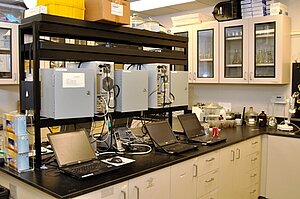
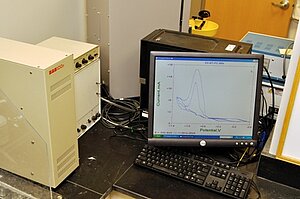
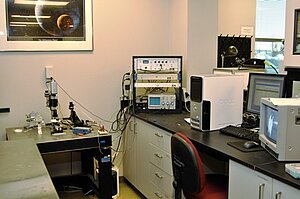
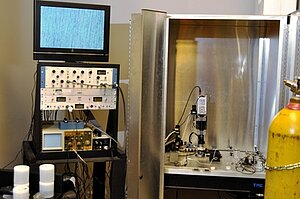
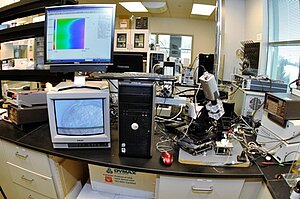
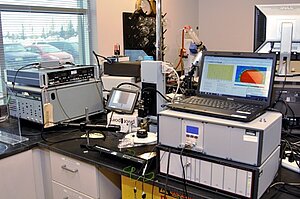
Gamry Potentiostats
2 Femtostats, 4 PC4, and 4 Reference 600 potentiostats
Useful for coating analysis via EIS and corrosion based DC electrochemistry as well as electrodeposition
Frequency range from 300,000 to 0.001 Hz
Maximum measurable impedance at 0.01 Hz is 1013 Ω
12V compliance potential at up to 30mA
Available techniques include EIS, open circuit potential, linear polarization, cyclic voltammetry, electrochemical noise, polarization resistance, chronoamperometry, chronocoulometry, and chronopotentiometry
Princeton Applied Research Potentiostats
1 Parstat 2273 and 2 Parstat 273A
Good for systems with high ohmic drop or when an expanded frequency range or high current is required
100V compliance potential at 2 amps
Frequency range of 1 MHz to 10 µHz
Capable of measuring impedances up to 1013 Ω.
Can run multisine EIS measuring multiple frequencies at the same time
Other experiments include standard EIS, linear sweep voltammetry, cyclic voltammetry, and pulse voltammetry
BAS 100 B Potentiostat
A potentiostat that is best suited to sensitive mechanistic and kinetic studies as well as electrodeposition
It can perform sweeping, step, pulse, polarography and square wave techniques as well as AC voltammetric and stripping techniques
The BAS 100B can perform EIS measurements but the frequency range is limited from 10-4 to 103 Hz
12 V compliance potential with 0.1 mV resolution
Scan rates from 100 µV/S to 300 V/S
Measures current from 100 nA to 100 mA
Rotating Disk Electrode
The rotating disk electrode is useful for mechanistic studies because the rotation of the working electrode controls the diffusion rate at the working electrode surface
Combination disk in ring electrodes allow many additional experiments not possible with a standard RDE
AFCBP1 bipotentiostat measures current from 100 nA up to 100 mA
Potential range from -10 V to 10 V with sweep rates from 1 mV/s to 1 V/s
Applicable Electronics Scanning Vibrating Electrode Technique (2)
The Applicable Electronics SVET system measures potential gradients in solution to calculate current.
This system detects areas of anodic and cathodic activity and measures the reaction rate in those areas with a noise level of 1-3 µA depending on the sample.
Applicable Electronics Scanning Ion Selective Electrode
This Applicable Electronics system uses a pulled pipette as a microelectrode to detect local ion concentrations.
An ionophore liquid in pipette tip undergoes ion exchange with the sample solution allowing concentration to be measured as potential.
Can measure local pH accurately from a pH of 2 to 9
CH Instruments Scanning Electrochemical Microscope
Model 920C from CH Instruments
Works well for imaging the electrochemical reactions on a surface.
Can also calculate the probe to sample distance to obtain a topographical map of a samples
Good at studying heterogeneous electron transfer reactions to obtain rate constants
3 or 4 electrode experiments can be performed
Measurable current range is 1 picoamp to 250 mA
Potential range of -10 V to 10V
Scan rates from 1 x 10-6 V/s to 10,000 V/s with 0.1 mV resolution
PAR/Uniscan Multi Technique System
This system is capable of performing multiple techniques over the same area
Available Techniques:
Scanning Kelvin Probe
SVET
Local EIS
Scanning Droplet Technique
Optical Scanning Profilometry
Allows for nondestructive and destructive sample analysis
Other Capabilites
Conductive and Electrochemical AFM
4 point probe conductivities
This Web page represents the views of the author and not necessarily those of North Dakota State University.
NDSU is not responsible or liable for its contents.